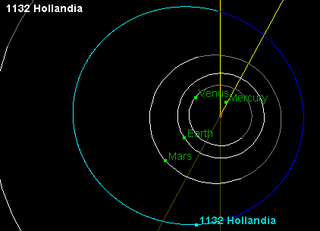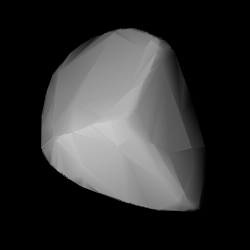Related Research Articles
4349 Tibúrcio, provisional designation 1989 LX, is a dark asteroid from the central region of the asteroid belt, approximately 29 kilometers in diameter. It was discovered on 5 June 1989, by German astronomer Werner Landgraf at ESO's La Silla Observatory in northern Chile.
Pawlowia, provisional designation 1923 OX, is a background asteroid from the central regions of the asteroid belt, approximately 20 kilometers in diameter. It was discovered on 5 October 1923, by Soviet astronomer Vladimir Albitsky at the Simeiz Observatory on the Crimean peninsula. The asteroid was named after Russian physiologist and Nobelist Ivan Pavlov.

1073 Gellivara, provisional designation 1923 OW, is a dark Themistian asteroid, approximately 27 kilometers in diameter, located in the outer regions of the asteroid belt. It was discovered by Austrian astronomer Johann Palisa at the Vienna Observatory on 14 September 1923, and later named after the Swedish town of Gällivare.
1027 Aesculapia, provisional designation A923 YO11, is a Themistian asteroid from the outer region of the asteroid belt, approximately 33 kilometers in diameter.

1032 Pafuri, provisional designation 1924 SA, is a dark background asteroid from the outer regions of the asteroid belt, approximately 65 kilometers in diameter. It was discovered on 30 May 1924, by English astronomer Harry Edwin Wood at the Union Observatory in Johannesburg, South Africa. The asteroid was named for the river in the Pafuri Triangle in South Africa, created by the confluence of the Limpopo and Levubu rivers. The body's spectral type and rotation period are still poorly determined.
1051 Merope is a dark Alauda asteroid from the outermost region of the asteroid belt, approximately 68 kilometers in diameter. It was discovered on 16 September 1925, by German astronomer Karl Reinmuth at the Heidelberg-Königstuhl State Observatory in Heidelberg, Germany, and given the provisional designation 1925 SA. Reinmuth named it after the nymph Merope from Greek mythology. The asteroid has a rotation period of 27.2 hours.

1132 Hollandia, provisional designation 1929 RB1, is a stony asteroid from the middle region of the asteroid belt, approximately 27 kilometers in diameter. It was discovered on 13 September 1929, by Dutch astronomer Hendrik van Gent at Leiden Southern Station, annex to the Johannesburg Observatory in South Africa. It was named for the region Holland in the Netherlands.

1555 Dejan, provisional designation 1941 SA, is an asteroid from the background population of the central regions of the asteroid belt, approximately 22 kilometers in diameter. It was discovered on 15 September 1941, by Belgian astronomer Fernand Rigaux at the Royal Observatory of Belgium in Uccle. The asteroid was named after Dejan Đurković, son of Serbian astronomer Petar Đurković.
3893 DeLaeter, provisional designation 1980 FG12, is an asteroid from the inner regions of the asteroid belt, approximately 12 kilometers in diameter. It was discovered on 20 March 1980, by British astronomer Michael Candy at the Perth Observatory in Bickley, Australia. The asteroid was named after Australian scientist John Robert de Laeter.
1541 Estonia, provisional designation 1939 CK, is an asteroid from the central regions of the asteroid belt, approximately 21 kilometers in diameter. It was discovered on 12 February 1939, by astronomer Yrjö Väisälä at the Iso-Heikkilä Observatory near Turku, Finland. The asteroid was named after the Baltic country of Estonia.
1267 Geertruida, provisional designation 1930 HD, is a carbonaceous background asteroid from the inner regions of the asteroid belt, approximately 20 kilometers in diameter. Discovered by astronomer Hendrik van Gent at Johannesburg Observatory in 1930, the asteroid was later named after Geertruid Pels, sister of Dutch astronomer Gerrit Pels.
2126 Gerasimovich, provisional designation 1970 QZ, is a stony background asteroid from the inner regions of the asteroid belt, approximately 8 kilometers in diameter. It was discovered on 30 August 1970, by Soviet astronomer Tamara Smirnova at the Crimean Astrophysical Observatory in Nauchnyj, on the Crimean peninsula. The asteroid was named after Russian astronomer Boris Gerasimovich.
2016 Heinemann, provisional designation 1938 SE, is a carbonaceous Themistian asteroid from the outer regions of the asteroid belt, approximately 22 kilometers in diameter. It was discovered on 18 September 1938, by German astronomer Alfred Bohrmann at Heidelberg Observatory in southwest Germany, and later named after ARI-astronomer Karl Heinemann (1898–1970).
2324 Janice, provisional designation 1978 VS4, is a dark background asteroid from the outer regions of the asteroid belt, approximately 25 kilometers (16 miles) in diameter. It was discovered on 7 November 1978, by American astronomers Eleanor Helin and Schelte Bus at the Palomar Observatory in California. The asteroid was named for Janice Cline at Caltech. The presumably C-type asteroid has a rotation period of 23.2 hours.
2173 Maresjev, provisional designation 1974 QG1, is a dark background asteroid from the outer regions of the asteroid belt, approximately 28 kilometers (17 miles) in diameter. It was discovered on 22 August 1974, by Soviet–Ukrainian astronomer Lyudmila Zhuravleva at the Crimean Astrophysical Observatory in Nauchnij, on the Crimean peninsula. It was named for Soviet war veteran Alexey Maresyev. The assumed C-type asteroid has a tentative rotation period of 11.6 hours.
2090 Mizuho, provisional designation 1978 EA, is a stony asteroid from the outer region of the asteroid belt, approximately 18 kilometers in diameter.
2043 Ortutay, provisional designation 1936 TH, is a dark asteroid from the outer regions of the asteroid belt, approximately 45 kilometers in diameter. The asteroid was discovered by Hungarian astronomer György Kulin at the Konkoly Observatory, Budapest, on 12 November 1936. It was named after Hungarian ethnographer Gyula Ortutay.

1546 Izsák, provisional designation 1941 SG1, is a background asteroid from the outer regions of the asteroid belt, approximately 27 kilometers in diameter. It was discovered on 28 September 1941, by Hungarian astronomer György Kulin at the Konkoly Observatory near Budapest, Hungary. The asteroid was named after Hungarian astronomer Imre Izsák.
1887 Virton, provisional designation 1950 TD, is a stony Eoan asteroid from the outer region of the asteroid belt, approximately 21 kilometers in diameter. It was discovered by Belgian astronomer Sylvain Arend at the Royal Observatory of Belgium in Uccle on 5 October 1950, and named after the Belgian town of Virton.
7526 Ohtsuka, provisional designation 1993 AA, is a stony asteroid from the inner regions of the asteroid belt, approximately 7 kilometers in diameter. It was discovered by Japanese astronomer Takeshi Urata at Nihondaira Observatory Oohira Station, Japan, on 2 January 1993. The asteroid was named after Japanese astronomer Katsuhito Ohtsuka.
References
- 1 2 3 4 "JPL Small-Body Database Browser: 4045 Lowengrub (1953 RG)" (2017-10-01 last obs.). Jet Propulsion Laboratory . Retrieved 7 November 2017.
- 1 2 3 Schmadel, Lutz D. (2007). "(4045) Lowengrub". Dictionary of Minor Planet Names. Springer Berlin Heidelberg. p. 345. doi:10.1007/978-3-540-29925-7_4025. ISBN 978-3-540-00238-3.
- 1 2 3 4 5 6 7 "LCDB Data for (4045) Lowengrub". Asteroid Lightcurve Database (LCDB). Retrieved 7 November 2017.
- 1 2 "Asteroid 4045 Lowengrub – Nesvorny HCM Asteroid Families V3.0". Small Bodies Data Ferret. Retrieved 27 October 2019.
- 1 2 3 4 Usui, Fumihiko; Kuroda, Daisuke; Müller, Thomas G.; Hasegawa, Sunao; Ishiguro, Masateru; Ootsubo, Takafumi; et al. (October 2011). "Asteroid Catalog Using Akari: AKARI/IRC Mid-Infrared Asteroid Survey". Publications of the Astronomical Society of Japan. 63 (5): 1117–1138. Bibcode:2011PASJ...63.1117U. doi:10.1093/pasj/63.5.1117. (online, AcuA catalog p. 153)
- 1 2 3 4 Mainzer, A.; Grav, T.; Masiero, J.; Hand, E.; Bauer, J.; Tholen, D.; et al. (November 2011). "NEOWISE Studies of Spectrophotometrically Classified Asteroids: Preliminary Results". The Astrophysical Journal. 741 (2): 25. arXiv: 1109.6407 . Bibcode:2011ApJ...741...90M. doi:10.1088/0004-637X/741/2/90. S2CID 35447010.
- 1 2 Masiero, Joseph R.; Mainzer, A. K.; Grav, T.; Bauer, J. M.; Cutri, R. M.; Dailey, J.; et al. (November 2011). "Main Belt Asteroids with WISE/NEOWISE. I. Preliminary Albedos and Diameters". The Astrophysical Journal. 741 (2): 20. arXiv: 1109.4096 . Bibcode:2011ApJ...741...68M. doi:10.1088/0004-637X/741/2/68. S2CID 118745497 . Retrieved 7 November 2017.
- 1 2 3 4 Masiero, Joseph R.; Mainzer, A. K.; Grav, T.; Bauer, J. M.; Cutri, R. M.; Nugent, C.; et al. (November 2012). "Preliminary Analysis of WISE/NEOWISE 3-Band Cryogenic and Post-cryogenic Observations of Main Belt Asteroids". The Astrophysical Journal Letters. 759 (1): 5. arXiv: 1209.5794 . Bibcode:2012ApJ...759L...8M. doi:10.1088/2041-8205/759/1/L8. S2CID 46350317 . Retrieved 7 November 2017.
- 1 2 3 Angeli, C. A.; Barucci, M. A. (March 1996). "CCD observations: rotational properties of 13 small asteroids". Planetary and Space Science. 44 (3): 181–186. Bibcode:1996P&SS...44..181A. doi:10.1016/0032-0633(95)00124-7 . Retrieved 7 November 2017.
- 1 2 "4045 Lowengrub (1953 RG)". Minor Planet Center. Retrieved 7 November 2017.
- ↑ Nesvorný, D.; Broz, M.; Carruba, V. (December 2014). "Identification and Dynamical Properties of Asteroid Families". Asteroids IV. pp. 297–321. arXiv: 1502.01628 . Bibcode:2015aste.book..297N. doi:10.2458/azu_uapress_9780816532131-ch016. ISBN 978-0-8165-3213-1. S2CID 119280014.
- ↑ "MPC/MPO/MPS Archive". Minor Planet Center. Retrieved 7 November 2017.